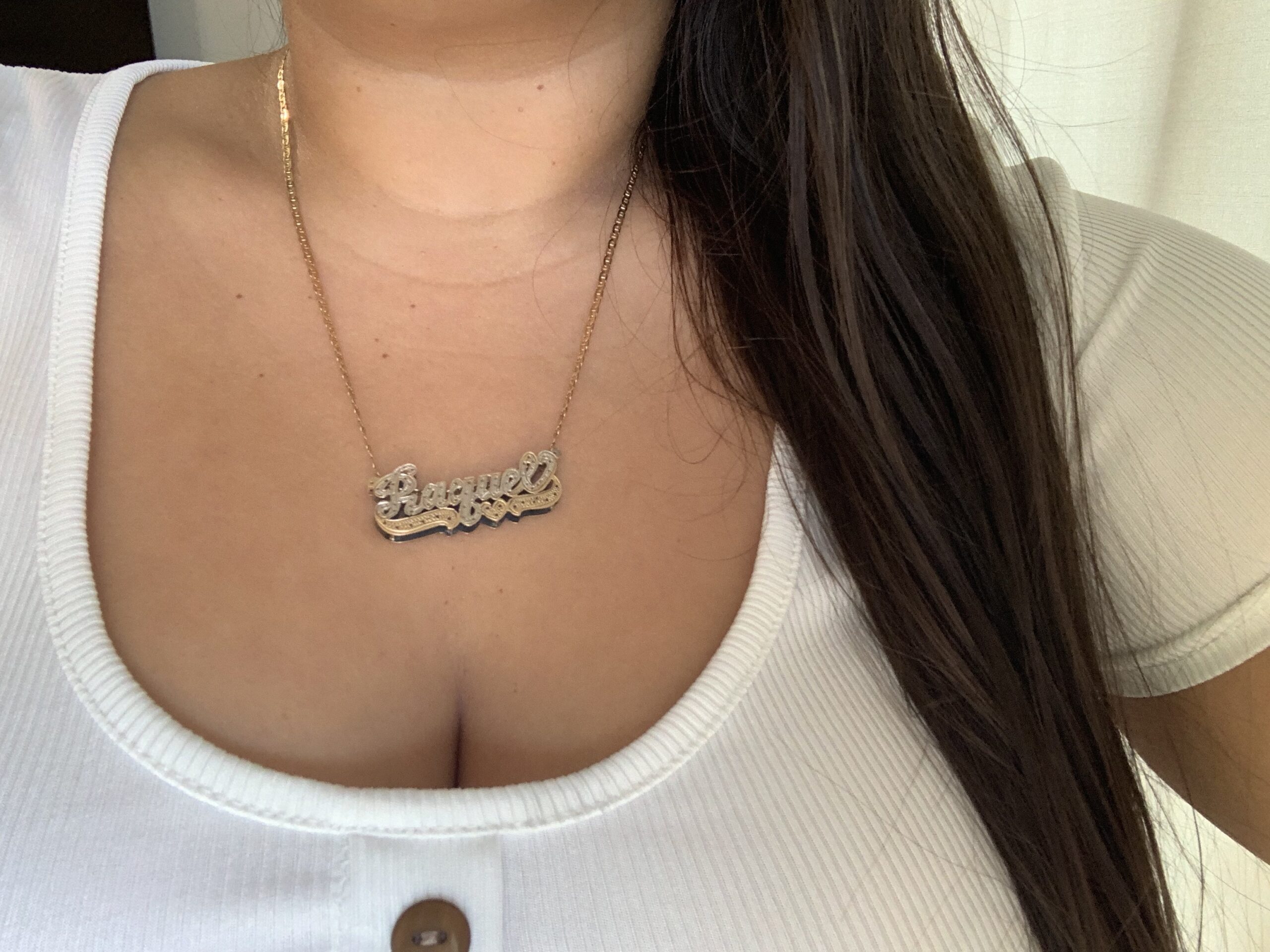How The Nameplate Necklace Has Become A Symbol Of Empowerment Among WOC
My neck has always announced who I am. When I was in elementary school, elaborate scripted letters spelled out my ethnic name—R.A.Q.U.E.L.—on a silver chain necklace. By middle school, I had graduated to a yellow-and-white gold double-plate pendant that underlined my name with a squiggly line and heart. Not long after, those six letters were inscribed on bamboo earrings, an XO link bracelet, a chunky ring, a belt, and the back pocket of my favorite V.I.M. jeans. As school teachers and administrators called me Rachel, I defiantly pointed to my jewelry to remind them to never anglicize the name my family blessed me with. These gaudy accessories allowed me to proclaim my identity and my presence in the world—and they were also unarguably cool.
In many ways, my nameplate necklace was an intentional departure from white mainstream culture.

At the same time, it was a shared experience of girlhood for low-income and working-class femmes of color. Around me, and in Black and Latinx neighborhoods across the country, the nameplate necklace was a coming of age statement. Like the gold hoops gifted to us in our youth, it was unclear when or where this cultural product was born, but we knew that these “ostentatious” pieces emblazoned with our “difficult-to-pronounce” names belonged to us.
According to anthropologists and cultural historians, nameplate jewelry isn’t unique to a specific time or culture. In Say My Name: Nameplate Jewelry and the Politics of Taste, authors Marcel Rosa-Salas and Isabel Flower define “nameplate” as an umbrella category for a jewelry design tradition that centers on a name. Under this definition, they argue that nameplate jewelry has several, sometimes overlapping, sociocultural and material lineages. During the Victorian era, upper-middle-class women sometimes wore silver name brooches. Similarly, some Jewish women wore silver brooches engraved with the word “mizpah,” which can loosely be interpreted as “May God watch over you,” during moments of loss. The authors also note that gold and platinum name bracelets made their way to the Hawaiian monarchy through early Victorian England settlers; the pieces featured Old English lettering carved into black enamel. Later in Panama, care jewelry, a regional style of nameplate bracelets and circular monogrammed pendants made from carved and painted buffalo bone and turtle shell, was created.
While nameplate jewelry has a long and diverse history, many scholars agree that the stylized nameplate necklace most commonly worn by Black and Latina girls and women across the nation today came out of New York City in the 1970s and ‘80s. In a Guardian video about the origins and cultural significance of the nameplate necklace, hip-hop archivist Prof Q, of the popular Instagram account albeesquare87, explains that gold nameplate pinky rings and necklaces were worn among street hustlers and pimps. As hip-hop began taking over the streets of New York, rappers were influenced by these “stars of the ghetto” and emulated their jewelry aesthetics. While the style immediately spread around the boroughs, it didn’t go national until Yo MTV Raps launched in 1988. The program helped hip-hop music, art and style reach a wider audience. According to Monica L. Miller, an English professor at Columbia University and author of Slaves to Fashion: Black Dandyism and the Styling of Black Diasporic Identity, this is when “Black street style became something everyone, everywhere had access to.”
With so few images of girls of color in mainstream media, Cornell University Professor Oneka LaBennett argues that seeing racialized bodies adorned with nameplate pieces was empowering for Black and Latinx girls in the 1980s and ‘90s.
For subjugated communities who were told their tastes, style and beauty were inferior to that of non-Latinx whites, the nameplate helped redefine what it meant to be fly. Even more, it was a marker of one’s existence in a society and culture that had tried to erase their humanity, through genocide, enslavement, police violence and institutionalized discrimination. “Much like graffiti-tagging, the nameplate became a way of saying, ‘I exist in this world. I want you to know my name,’” LaBennett said.
With the U.S. origin and significance of the nameplate necklace rooted in marginalized identity and resistance, its mainstream consumption (i.e. popularity among non-Latinx white women) has prompted criticism. For many white Americans, the nameplate necklace lost its “tackiness” when it was worn by Sex and the City character Carrie Bradshaw (played by Sarah Jessica Parker) in the late ‘90s and early 2000s. The series’ costume designer Patricia Field confessed she saw Black and Puerto Rican kids on her block donning the staple and decided to place one on its lead white character. In doing so, the series commercialized the cultural product and, intentionally or not, constructed the “Carrie necklace,” a now trendy and respectable designation for the nameplate necklace. Overnight, what was once perceived as ghetto became fashionable. “The trends that Black youth have created have always been absorbed by mainstream society, and the nameplate necklace is no different. Black culture is used as an alternative playground for whites, so when mainstream society wants to cut loose and be wild, that’s when Black culture can be absorbed,” LaBennett said.
As much as the nameplate necklace is a racial and ethnic signifier, it’s also a class one.
For Black and Latina girls, it’s a coming-of-age piece that low-income parents save up to buy for their child or teen.
Understanding the nickels and dimes that are set aside for the pricey gift, and the responsibility given to young people to wear that much cash around their necks, it also felt dismissive when Carrie, in the series finale of Sex and the City, minimized its value. In the episode, the character is upset that she lost the famous necklace. She says, “It costs like nothing, but it’s priceless.” As argued by journalist Collier Meyerson, while Carrie acknowledges the piece’s cultural significance as invaluable, she disregards the actually-high-cost jewelry that is often deeply felt by parents and single moms.
It’s been decades since my mother clasped my first nameplate piece around my neck, an item I still own, value and wear, but since then I’ve witnessed how the style has been appropriated by people who don’t hold its cultural history and significance as dear to them as I do. In many ways, they can’t. When Raquel glows from my neck, it forces you to recognize and say my name—even if it’s a struggle for you to pronounce. Its two tones reject dominant ideas of vogue and respectability. Its shine reminds me that I light up every space I was told I don’t belong in. And its golden heart sends love to all the hard-working Latina and Black mamis who gifted us with this glorious cultural marker as well as the fly racialized bodies who made—and continue to make—the piece so damn poppin’.
Click here to learn more about all the places that are Just An Amtrak Away.




